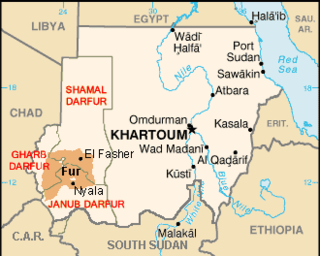Ganda or Luganda is a Bantu language spoken in the African Great Lakes region. It is one of the major languages in Uganda and is spoken by more than 5.56 million Baganda and other people principally in central Uganda, including the country's capital, Kampala. Typologically, it is an agglutinative, tonal language with subject–verb–object word order and nominative–accusative morphosyntactic alignment.

The Cheyenne language is the Native American language spoken by the Cheyenne people, predominantly in present-day Montana and Oklahoma, in the United States. It is part of the Algonquian language family. Like all other Algonquian languages, it has complex agglutinative polysynthetic morphology. This language is considered endangered, at different levels, in both states.

The Samburu are a Nilotic people of north-central Kenya. Traditionally, they are semi-nomadic pastoralists who primarily herd cattle but also keep sheep, goats and camels. They refer to themselves as Lokop or Loikop, a term with varied interpretations among the Samburu. Some believe it means "owners of the land" while others have different interpretations.

The Fur language or For; is a Nilo-Saharan language spoken by the Fur of Darfur in Western Sudan and Chad. It is part of a broader family of languages known as the Fur languages.
The Tagoi language is a Kordofanian language, closely related to Tegali, spoken near the town of Rashad in southern Kordofan in Sudan, about 12 N, 31 E. Unlike Tegali, it has a complex noun class system, which appears to have been borrowed from more typical Niger–Congo languages. It has several dialects, including Umali (Tumale), Goy, Moreb, and Orig. Villages are Moreb, Tagoi, Tukum, Tuling, Tumale, Turjok, and Turum.
The Eastern Nilotic languages are one of the three primary branches of the Nilotic languages, themselves belonging to the Eastern Sudanic subfamily of Nilo-Saharan; they are believed to have begun to diverge about 3,000 years ago, and have spread southwards from an original home in Equatoria in South Sudan. They are spoken across a large area in East Africa, ranging from Equatoria to the highlands of Tanzania. Their speakers are mostly cattle herders living in semi-arid or arid plains.

Supyire, or Suppire, is a Senufo language spoken in the Sikasso Region of southeastern Mali and in adjoining regions of Ivory Coast. In their native language, the noun sùpyìré means both "the people" and "the language spoken by the people".
Goemai is an Afro-Asiatic language spoken in the Great Muri Plains region of Plateau State in central Nigeria, between the Jos Plateau and Benue River. Goemai is also the name of the ethnic group of speakers of the Goemai language. The name 'Ankwe' has been used to refer to the people, especially in older literature and to outsiders. As of 2020, it is estimated that there are around 380,000 Goemai speakers.
The Elgeyo language, or Kalenjin proper, are a dialect cluster of the Kalenjin branch of the Nilotic language family.
Tariana is an endangered Maipurean language spoken along the Vaupés River in Amazonas, Brazil by approximately 100 people. Another approximately 1,500 people in the upper and middle Vaupés River area identify themselves as ethnic Tariana but do not speak the language fluently.
The Yimas language is spoken by the Yimas people, who populate the Sepik River Basin region of Papua New Guinea. It is spoken primarily in Yimas village, Karawari Rural LLG, East Sepik Province. It is a member of the Lower-Sepik language family. All 250-300 speakers of Yimas live in two villages along the lower reaches of the Arafundi River, which stems from a tributary of the Sepik River known as the Karawari River.

The Nukak language is a language of uncertain classification, perhaps part of the macrofamily Puinave-Maku. It is very closely related to Kakwa.
Arbore is an Afro-Asiatic language spoken by the Arbore people in southern Ethiopia in a few settlements of Hamer woreda near Lake Chew Bahir.
Baiso or Bayso is a Lowland East Cushitic language belonging to the Omo–Tana subgroup, and is spoken in Ethiopia, in the region around Lake Abaya.

Iraqw is a Cushitic language spoken in Tanzania in the Arusha and Manyara Regions. It is expanding in numbers as the Iraqw people absorb neighbouring ethnic groups. The language has many Datooga loanwords, especially in poetic language. The Gorowa language, to the south, shares numerous similarities and is sometimes considered a dialect.
Warndarrang (waɳʈaraŋ), also spelt Warndarang, Wanderang, Wandaran, and other variants is an extinct Aboriginal Australian language in the Arnhem family, formerly spoken by the Warndarrang people in southern Arnhem Land, along the Gulf of Carpentaria. The last speaker was Isaac Joshua, who died in 1974, while working with the linguist Jeffrey Heath.
Ebrié, or Cama, is spoken by the Tchaman people in Ivory Coast and Ghana. It is a Potou language of the Kwa branch of the Niger–Congo family of languages.
Macedonian conjugation is the creation of derived forms of a Macedonian verb from its principal parts by inflection.

Matlatzinca, or more specifically San Francisco Matlatzinca, is an endangered Oto-Manguean language of Western Central Mexico.[3] The name of the language in the language itself is pjiekak'joo.[4] The term "Matlatzinca" comes from the town's name in Nahuatl, meaning "the lords of the network." At one point, the Matlatzinca groups were called "pirindas," meaning "those in the middle."[5]
The Laikipiak people were a community that inhabited the plateau located on the eastern escarpment of the Rift Valley in Kenya that today bears their name. They are said to have arisen from the scattering of the Kwavi by the Maasai in the 1830s.They were one of two significant sections of that community that stayed together. The other being the Uasin Gishu with whom they would later ally against the Maasai. Many Maa-speakers in Laikipia County today claim Laikipiak ancestry, namely those among the Ilng'wesi, Ildigirri and Ilmumonyot sub-sections of the Laikipia Maasai.







